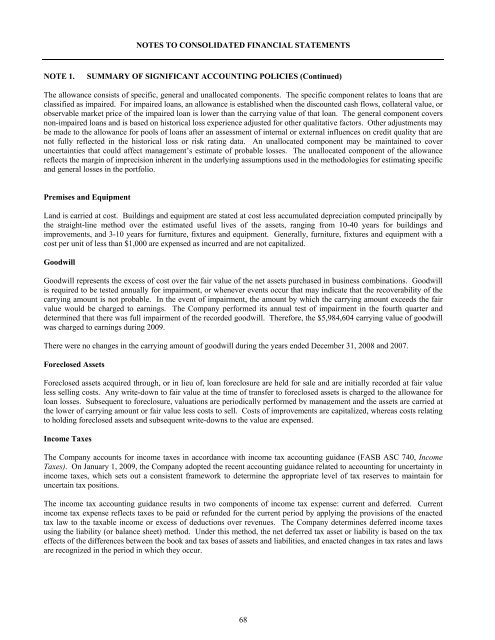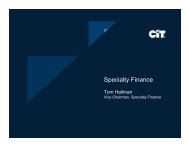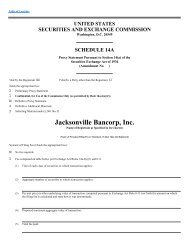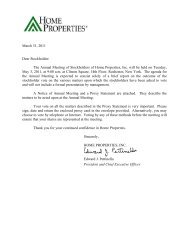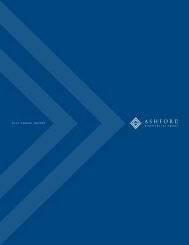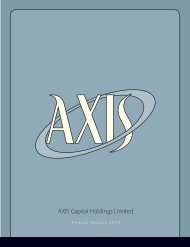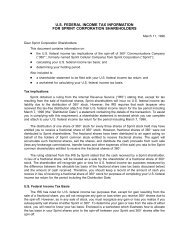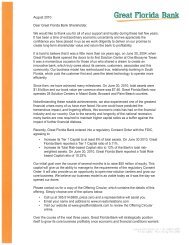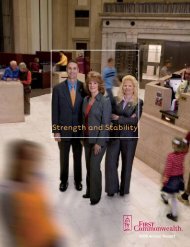pab bankshares, inc. - SNL Financial
pab bankshares, inc. - SNL Financial
pab bankshares, inc. - SNL Financial
Create successful ePaper yourself
Turn your PDF publications into a flip-book with our unique Google optimized e-Paper software.
NOTES TO CONSOLIDATED FINANCIAL STATEMENTS<br />
NOTE 1.<br />
SUMMARY OF SIGNIFICANT ACCOUNTING POLICIES (Continued)<br />
The allowance consists of specific, general and unallocated components. The specific component relates to loans that are<br />
classified as impaired. For impaired loans, an allowance is established when the discounted cash flows, collateral value, or<br />
observable market price of the impaired loan is lower than the carrying value of that loan. The general component covers<br />
non-impaired loans and is based on historical loss experience adjusted for other qualitative factors. Other adjustments may<br />
be made to the allowance for pools of loans after an assessment of internal or external influences on credit quality that are<br />
not fully reflected in the historical loss or risk rating data. An unallocated component may be maintained to cover<br />
uncertainties that could affect management’s estimate of probable losses. The unallocated component of the allowance<br />
reflects the margin of imprecision inherent in the underlying assumptions used in the methodologies for estimating specific<br />
and general losses in the portfolio.<br />
Premises and Equipment<br />
Land is carried at cost. Buildings and equipment are stated at cost less accumulated depreciation computed pr<strong>inc</strong>ipally by<br />
the straight-line method over the estimated useful lives of the assets, ranging from 10-40 years for buildings and<br />
improvements, and 3-10 years for furniture, fixtures and equipment. Generally, furniture, fixtures and equipment with a<br />
cost per unit of less than $1,000 are expensed as <strong>inc</strong>urred and are not capitalized.<br />
Goodwill<br />
Goodwill represents the excess of cost over the fair value of the net assets purchased in business combinations. Goodwill<br />
is required to be tested annually for impairment, or whenever events occur that may indicate that the recoverability of the<br />
carrying amount is not probable. In the event of impairment, the amount by which the carrying amount exceeds the fair<br />
value would be charged to earnings. The Company performed its annual test of impairment in the fourth quarter and<br />
determined that there was full impairment of the recorded goodwill. Therefore, the $5,984,604 carrying value of goodwill<br />
was charged to earnings during 2009.<br />
There were no changes in the carrying amount of goodwill during the years ended December 31, 2008 and 2007.<br />
Foreclosed Assets<br />
Foreclosed assets acquired through, or in lieu of, loan foreclosure are held for sale and are initially recorded at fair value<br />
less selling costs. Any write-down to fair value at the time of transfer to foreclosed assets is charged to the allowance for<br />
loan losses. Subsequent to foreclosure, valuations are periodically performed by management and the assets are carried at<br />
the lower of carrying amount or fair value less costs to sell. Costs of improvements are capitalized, whereas costs relating<br />
to holding foreclosed assets and subsequent write-downs to the value are expensed.<br />
Income Taxes<br />
The Company accounts for <strong>inc</strong>ome taxes in accordance with <strong>inc</strong>ome tax accounting guidance (FASB ASC 740, Income<br />
Taxes). On January 1, 2009, the Company adopted the recent accounting guidance related to accounting for uncertainty in<br />
<strong>inc</strong>ome taxes, which sets out a consistent framework to determine the appropriate level of tax reserves to maintain for<br />
uncertain tax positions.<br />
The <strong>inc</strong>ome tax accounting guidance results in two components of <strong>inc</strong>ome tax expense: current and deferred. Current<br />
<strong>inc</strong>ome tax expense reflects taxes to be paid or refunded for the current period by applying the provisions of the enacted<br />
tax law to the taxable <strong>inc</strong>ome or excess of deductions over revenues. The Company determines deferred <strong>inc</strong>ome taxes<br />
using the liability (or balance sheet) method. Under this method, the net deferred tax asset or liability is based on the tax<br />
effects of the differences between the book and tax bases of assets and liabilities, and enacted changes in tax rates and laws<br />
are recognized in the period in which they occur.<br />
68


